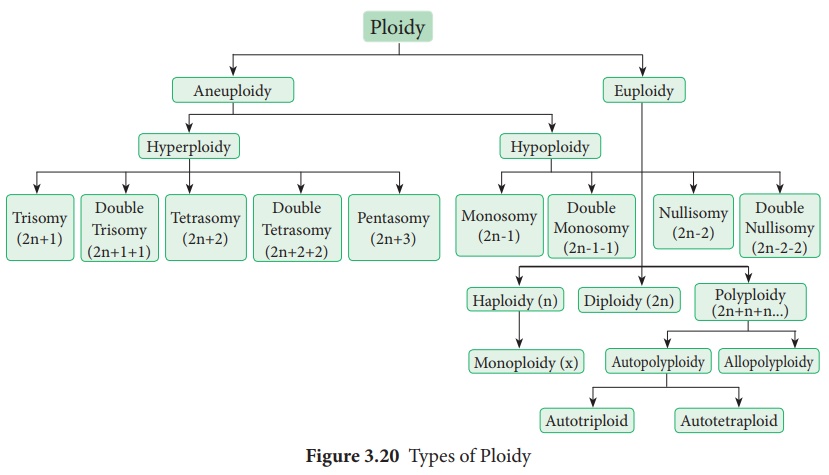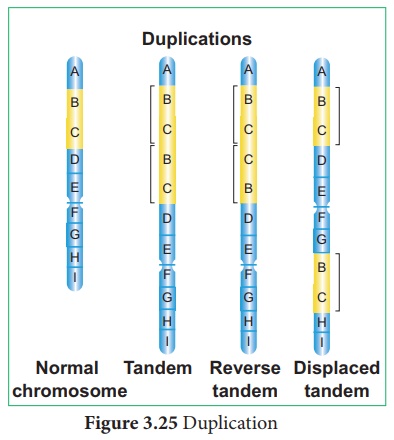Botany : Chromosomal Basis of Inheritance - Chromosomal mutations | 12th Botany : Chapter 3 : Chromosomal Basis of Inheritance
Chapter: 12th Botany : Chapter 3 : Chromosomal Basis of Inheritance
Chromosomal mutations
Chromosomal mutations
The genome can also be modified on a larger scale by altering the chromosome structure or by changing the number of chromosomes in a cell. These large-scale variations are termed as chromosomal mutations or chromosomal aberrations. Gene mutations are changes that take place within a gene, whereas chromosomal mutations are changes to a chromosome region consisting of many genes. It can be detected by microscopic examination, genetic analysis, or both. In contrast, gene mutations are never detectable microscopically. Chromosomal mutations are divided into two groups: changes in chromosome number and changes in chromosome structure.
1. Changes in chromosome number
Each cell of living organisms possesses fixed number of chromosomes. It varies in different species. Even though some species of plants and animals are having identical number of chromosomes, they will not be similar in character. Hence the number of chromosomes will not differentiate the character of species from one another but the nature of hereditary material (gene) in chromosome that determines the character of species.
Sometimes the chromosome number of somatic cells are changed due to addition or elimination of individual chromosome or basic set of chromosomes. This condition in known as numerical chromosomal aberration or ploidy. There are two types of ploidy.
(i). Ploidy involving individual chromosomes within a diploid set (Aneuploidy)
(ii). Ploidy involving entire sets of chromosomes (Euploidy) (Figure 3.20)

(i) Aneuploidy
It is a condition in which diploid number is altered either by addition or deletion of one or more chromosomes. Organisms showing aneuploidy are known as aneuploids or heteroploids . They are of two types, Hyperploidy and Hypoploidy (Figure 3.21).

1. Hyperploidy
Addition of one or more chromosomes to diploid sets are called hyperploidy. Diploid set of chromosomes represented as Disomy. Hyperploidy can be divided into three types. They are as follows,
(a) Trisomy
Addition of single chromosome to diploid set is called Simple trisomy(2n+1). Trisomics were first reported by Blackeslee (1910) in Datura stramonium (Jimson weed). But later it was reported in Nicotiana, Pisum and Oenothera. Sometimes addition of two individual chromosome from different chromosomal pairs to normal diploid sets are called Double trisomy (2n+1+1).
(b) Tetrasomy
Addition of a pair or two individual pairs of chromosomes to diploid set is called tetrasomy (2n+2) and Double tetrasomy (2n+2+2) respectively. All possible tetrasomics are available in Wheat.
(c) Pentasomy
Addition of three individual chromosome from different chromosomal pairs to normal diploid set are called pentasomy (2n+3).
2. Hypoploidy
Loss of one or more chromosome from the diploid set in the cell is called hypoploidy. It can be divided into two types. They are
(a) Monosomy
Loss of a single chromosome from the diploid set are called monosomy(2n-1). However loss of two individual or three individual chromosomes are called double monosomy (2n-1-1) and triple monosomy (2n-1-1-1) respectively. Double monosomics are observed in maize.
(b) Nullisomy
Loss of a pair of homologous chromosomes or two pairs of homologous chromosomes from the diploid set are called Nullisomy (2n-2) and double Nullisomy (2n-2-2) respectively. Selfing of monosomic plants produce nullisomics. They are usually lethal.
(ii) Euploidy
Euploidy is a condition where the organisms possess one or more basic sets of chromosomes. Euploidy is classified as monoploidy, diploidy and polyploidy. The condition where an organism or somatic cell has two sets of chromosomes are called diploid (2n). Half the number of somatic chromosomes is referred as gametic chromosome number called haploid(n). It should be noted that haploidy (n) is different from a monoploidy (x). For example, the common wheat plant is a polyploidy (hexaploidy) 2n=6x=72 chromosomes. Its haploid number (n) is 36, but its monoploidy (x) is 12. Therefore, the haploid and diploid condition came regularly one after another and the same number of chromosomes is maintained from generation to generation, but monoploidy condition occurs when an organism is under polyploidy condition. In a true diploid both the monoploid and haploid chromosome number are same. Thus a monoploid can be a haploid but all haploids cannot be a monoploid.
Polyploidy
Polyploidy is the condition where an organism possesses more than two basic sets of chromosomes. When there are three, four, five or six basic sets of chromosomes, they are called triploidy (3x) tetraploidy (4x), pentaploidy (5x) and hexaploidy (6x) respectively. Generally, polyploidy is very common in plants but rarer in animals. An increase in the number of chromosome sets has been an important factor in the origin of new plant species. But higher ploidy level leads to death. Polyploidy is of two types. They are autopolyploidy and allopolyploidy
1. Autopolyploidy
The organism which possesses more than two haploid sets of chromosomes derived from within the same species is called autopolyploid. They are divided into two types. Autotriploids and autotetraploids.
Autotriploids have three set of its own genomes. They can be produced artificially by crossing between autotetraploid and diploid species. They are highly sterile due to defective gamete formation. Example: The cultivated banana are usually triploids and are seedless having larger fruits than diploids. Triploid sugar beets have higher sugar content than diploids and are resistant to moulds. Common doob grass (Cyanodon dactylon) is a natural autotriploid. Seedless watermelon, apple, sugar beet, tomato, banana are man made autotriploids.
Autotetraploids have four copies of its own genome. They may be induced by doubling the chromosomes of a diploid species. Example: rye, grapes, alfalfa, groundnut, potato and coffee.
2. Allopolyploidy
An organism which possesses two or more basic sets of chromosomes derived from two different species is called allopolyploidy. It can be developed by interspecific crosses and fertility is restored by chromosome doubling with colchicine treatment. Allopolyploids are formed between closely related species only. (Figure 3.22)

Example:1 Raphanobrassica, G.D. Karpechenko (1927) a Russian geneticist, crossed the radish (Raphanus sativus, 2n=18) and cabbage (Brassica oleracea, 2n=18) to produce F1 hybrid which was sterile. When he doubled the chromosome of F1 hybrid he got it fertile. He expected this plant to exhibit the root of radish and the leaves like cabbage, which would make the entire plant edible, but the case was vice versa, so he was greatly disappointed.
Example: 2 Triticale, the successful first man made cereal. Depending on the ploidy level Triticale can be divided into three main groups.
(i). Tetraploidy: Crosses between diploid wheat and rye.
(ii). Hexaploidy: Crosses between tetraploid wheat Triticum durum (macaroni wheat) and rye
(iii). Octoploidy: Crosses between hexaploid wheat T. aestivum (bread wheat) and rye
Hexaploidy Triticale hybrid plants demonstrate characteristics of both macaroni wheat and rye. For example, they combine the high-protein content of wheat with rye’s high content of the amino acid lysine, which is low in wheat. It can be explained by chart below (Figure: 3.23).

Colchicine , an alkaloid is extracted from root and corms of Colchicum autumnale, when applied in low concentration to the growing tips of the plants it will induce polyploidy. Surprisingly it does not affect the source plant Colchicum, due to presence of anticolchicine.

Significance of Ploidy
· Many polyploids are more vigorous and more adaptable than diploids.
· Many ornamental plants are autotetraploids and have larger flower and longer flowering duration than diploids.
· Autopolyploids usually have increase in fresh weight due to more water content.
· Aneuploids are useful to determine the phenotypic effects of loss or gain of different chromosomes.
· Many angiosperms are allopolyploids and they play a role in an evolution of plants.
II Structural changes in chromosome (Structural chromosomal aberration)
Structural variations caused by addition or deletion of a part of chromosome leading to rearrangement of genes is called structural chromosomal aberration. It occurs due to ionizing radiation or chemical compounds. On the basis of breaks and reunion in chromosomes, there are four types of aberrations. They are classified under two groups.
A. Changes in the number of the gene loci
1. Deletion or Deficiency
2. Duplication or Repeat
B. Changes in the arrangement of gene loci
3. Inversion
4. Translocation
1. Deletion or Deficiency
Loss of a portion of chromosome is called deletion. On the basis of location of breakage on chromosome, it is divided into terminal deletion and intercalary deletion. It occurs due to chemicals, drugs and radiations. It is observed in Drosophila and Maize. (Figure 3.24)

There are two types of deletion:
i. Terminal deletion: Single break in any one end of the chromosome.
ii. Intercalary deletion or interstitial deletion: It is caused by two breaks and reunion of terminal parts leaving the middle.
Both deletions are observable during meiotic pachytene stage and polytene chromosome. The unpaired loop formed in the normal chromosomal part at the time of chromosomal pairing. Such loops are called as deficiency loops and it can be seen in meiotic prophase. Larger deletions may lead to lethal effect.
2. Duplication or Repeat
The process of arrangement of the same order of genes repeated more than once in the same
Due to duplication some genes are present in more than two copies. It was first reported in Drosophila by Bridges (1919) and other examples are Maize and Pea. It is three types.
i. Tandem duplication
The duplicated segment is located immediately after the normal segment of the chromosome in the same order.
ii. Reverse tandem duplication
The duplicated segment is located immediately after the normal segment but the gene sequence order will be reversed.
iii. Displaced duplication
The duplicated segment is located in the same chromosome, but away from the normal segment. (Figure 3.25)

Duplications play a major role in evolution.
3. Inversion
A rearrangement of order of genes in a chromosome by reversed by an angle 1800. This involve two chromosomal breaks and reunion. During this process there is neither gain nor loss but the gene sequences is rearranged. Inversion was first reported in Drosophila by Sturtevant (1926). There are two types of inversion, paracentric and pericentric (Figure 3.26).

i. Paracentric inversion: An inversion which takes place apart from the centromere
ii. Pericentric inversion: An inversion that includes the centromere.
Inversions lead to evolution of a new species.
4. Translocation
The transfer of a segment of chromosome to a non-homologous chromosome is called translocation. Translocation should not be confused with crossing over, in which an exchange of genetic material between homologous chromosome takes place. Translocation occurs as a result of interchange of chromosome segments in non-homologous chromosomes. There are three types
i. Simple translocation
ii. Shift translocation
iii. Reciprocal translocation
i. Simple translocation
A single break is made in only one chromosome. The broken segment gets attached to one end of a non-homologous chromosome. It occurs very rarly in nature.
ii. Shift translocation
Broken segment of one chromosome gets inserted interstitially in a non-homologous chromosome.
iii. Reciprocal translocations
It involves mutual exchange of chromosomal segments between two non-homologous chromosomes. It is also called illegitimate crossing over. It is further divided into two types (Figure 3.27).

a. Homozygous translocation: Both the chromosomes of two pairs are involved in translocation. Two homologous of each translocated chromosomes are identical.
b. Heterozygous translocation: Only one of the chromosome from each pair of two homologous are involved in translocation, while the remaining chromosome is normal.
Translocations play a major role in the formation of species.
Related Topics